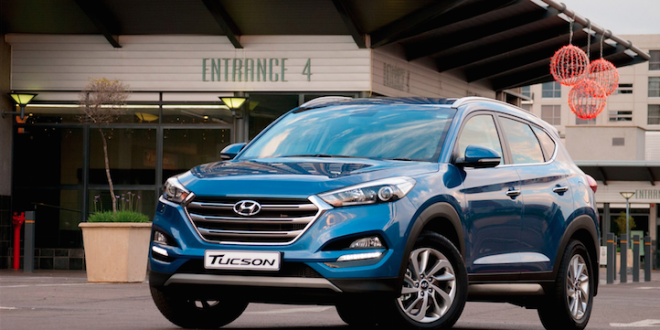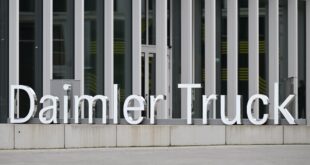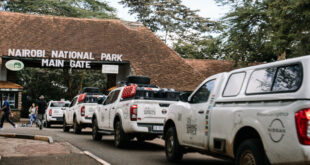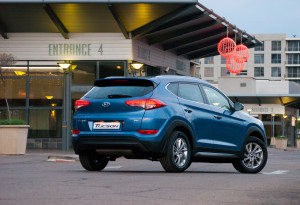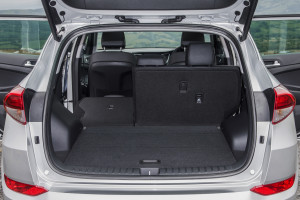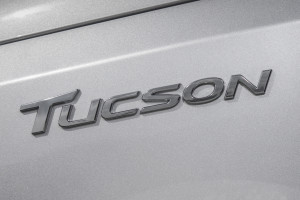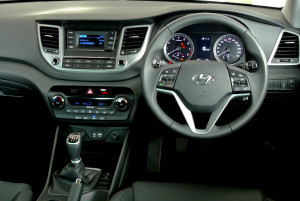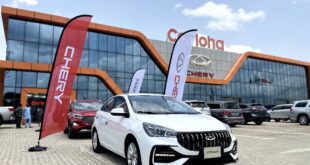Two new Tucsons – both with turbocharged diesel engines – have been added to Hyundai’s compact SUV range that became a top-seller in its market segment in South Africa since the local launch of this model earlier in 2016.
The addition of the turbodiesel engines has increased the derivatives in Hyundai’s Tucson range to seven, including the 5 petrol derivatives available since the launch in March.
Originally launched in 2005, the Hyundai Tucson caught the attention of South Africa SUV buyers and became a firm top-seller in the segment for several years when it was followed its successor, the ix35, in 2009.
“The overall total of 56 408 first generation Tucson and ix35 sales is proof of the popularity of Hyundai’s SUV, and since the launch of the new Tucson earlier in 2016 we have sold an average of more than 600 units per month. That puts us firmly in the top position in this market segment,” says Stanley Anderson, sales and operations director of Hyundai Automotive South Africa.
“The Tucson turbodiesels – launched at a very competitive price and with a comprehensive standard package – will certainly add a further boost to Hyundai Automotive South Africa’s sales and to its positive brand image. It is a welcome expansion of our range at a time when our automotive market is under pressure.”
One of the turbodiesel derivatives – on the Executive specification level – is powered by a new 1,7-litre engine that conforms to Euro 6 regulations for clean emissions and delivers 85 kW maximum power at 4 000 r/min. and 280 Nm peak torque between 1 250 and 2 750 r/min. Power is transferred to the front wheels via a six-speed manual gearbox.
The other Tucson turbodiesel derivative is equipped with a full range of standard features at the Elite specification level and uses a 2-litre Euro 2 engine that delivers 131 kW maximum power at 4 000 r/min., and 400 Nm torque between 1750 and 2 750 r/min. A six-speed automatic transmission transfers power to the front wheels.
The turbodiesel duo have been added to the Hyundai Tucson petrol engine derivatives that range from the entry-level Hyundai Tucson 2.0 Premium with either a manual 6-speed gearbox or automatic 6-speed transmission, to the range-topping Hyundai Tucson 1.6 TGDi Elite (turbocharged petrol engine) with the 7-speed Dual-Clutch Transmission (7DCT) and All-Wheel Drive.
In between lies the Hyundai Tucson 2.0 Nu Elite, also with the 2-litre petrol engine and automatic 6-speed transmission, but with a high level of standard features. One step down in terms of standard features is the Hyundai Tucson 1.6 TGDi Executive, also with the new turbocharged 1,6-litre petrol engine, but with a manual 6-speed gearbox. The Executive offers a level of comfort and standard features that fits in between the Premium and Elite offerings.
The launch price of the new Tucson 1.7 Executive Turbodiesel (manual gearbox) is R439 900, while the Tucson R2.0 Elite (with an automatic gearbox) sells for R519 900.
Engines and Transmissions
The two turbodiesel engines take their place next to the naturally aspirated 2-litre petrol engine and turbocharged 1.6-litre T-GDI petrol engine that was introduced with the Tucson in March in South Africa.
The new Tucson 1.7 Executive Turbodiesel is built in Hyundai’s modern factory in the Czech Republic. A cylinder block with a weight reduction of 5 kg, an improved 2 000 bar high-pressure fuel injection system, and a Lean NOx Trap (LNT) catalytic converter makes this advanced turbodiesel an excellent choice for fuel-efficient, yet powerful driving. The maximum torque, 280 Nm, can be delivered from a low 1 250 r/min.
This engine employs an Exhaust Gas Recirculation (EGR) system that, together with the LNT catalytic converter, results in cleaner exhaust gases and a CO2 emissions figure of 124 g/km. Average fuel consumption on a combined test cycle was measured at 6,8 litres per 100 km.
The 1,7-litre turbodiesel is paired with a smooth six-speed manual gearbox which drives the car through the front wheels.
The 2-litre diesel engine, in the Elite derivative that is imported from South Korea, is also equipped with a turbocharger that enables it to deal particularly well with the oxygen-starved Highveld and other high-lying and mountainous areas in South Africa.
It delivers 131 kW at 4 000 r/min., and its torque delivery peaks at an impressive 400 Nm from 1 750 to 2 750 r/min. Its CO2 emissons was measured at 175 g/km. The engine is paired with a six-speed automatic gearbox with a torque converter.
Design
Bold and athletic exterior creates unique SUV appearance
The Tucson design concept incorporates a sleek, urban style combined with the strong ruggedness typical of an SUV.
“Design expresses our progressive spirit and passion, and it is transforming our brand. The All-New Tucson has a distinctive and athletic presence achieved through refined, flowing surfaces, bold proportions, sharp lines and most importantly, our newest generation hexagonal grille – our brand signature,” says Peter Schreyer, President and Chief Design Officer at Hyundai Motor Group.
Exterior
The front of the Tucson is dominated by the hexagonal grille, which connects with the LED projection headlamps to create a distinctive identity. The headlamps feature static bending to the direction that one is travelling in a curve in the road.
A wing-shaped horizontal bar at the front bumper, which incorporates the LED daytime running lights, gives the car a unique style and provides a visual reference for the car’s wide track. Its looks is further enhanced by a silver skid plate and two-tone bumper.
At the rear, the Tucson’s personality is reinforced by strong horizontal lines flowing from the wheel arches. The LED combination lights and reflectors are stretched to the body edges to further underline the bold proportions, with the rear skid plate and twin exhaust outlet (in the 2.0 Elite derivative) adding a sporty touch.
The Tucson 1.7 Executive Diesel (manual) has 17-inch alloy wheels, while the Tucson 2.0 Elite (automatic) runs on 18-inch alloy wheels.
Refined interior combines elegance with ergonomics
The Hyundai interior design team’s objective was to ensure that potential buyers will be instinctively impressed by the cabin’s space and the attention paid to the smallest details.
Inside, soft-touch, high-quality materials are used across the cabin surfaces, creating a refined cabin ambience. The new horizontal layout of the centre console conveys the car’s elegance while increasing the feeling of roominess.
Sophisticated exterior and interior colour palette
The Tucson is offered with a range of ten exterior colours, comprising one solid (Polar White), four metallic (Platinum Silver, Ara Blue, White Sand and Milky Tea) and five pearl colours (Ash Blue, Ultimate Red, Phantom Black, Micron and Pepper Grey).
Borh turbodiesel derivatives come with the Oceanids Black interior package, including leather seats and a leather-covered multifunction steering wheel.
Comfort and Convenience
A number of clever convenience and connectivity features add refinement to the cabin and enhance the on-board experience.
Front seats feature long seat cushions and comes with electric power adjustment for the driver and front passenger in the Elite derivatives, and two-way electric powered lumbar support for the driver’s seat.
Generous space from efficient packaging
The new Tucson is built on a completely new platform that offers generous interior dimensions. There is an excellent exterior-to-interior dimension ratio, continuing the Hyundai tradition for highly efficient packaging.
With all seats upright, the roomy luggage area is 1 030 mm wide, 889 mm deep and 806 mm tall, delivering up to a substantial 513 litres of capacity. This can be increased to a maximum of 1 503 litres with the rear seats folded. Practicality is boosted by a lower trunk-sill height, two-level trunk floor and a stowable cargo cover.
Convenience and connectivity features are tailored to customer needs
The interior has been ergonomically designed to enable intuitive operation. The instrument cluster has been positioned towards the windscreen for excellent visibility and minimum distraction. The A-pillar has been engineered to reduce blind-spot width by 6 mm compared to the previous model, with visibility from the lower side window increased by 37 mm. In the Elite derivative a panoramic sunroof adds to the airy feel, providing 30% wider opening than before.
Both turbodiesels have electric adjustment for the driver and front passenger seats; a dual zone automatic climate control system; air vents for rear passengers; glove box cooling; cruise control with buttons on the steering wheel; and a rear view camera with display in the rear view mirror.
The centre console of the Tucson features a sound system with Bluetooth connectivity than enables music to be streamed from a smartphone or iPod, and connecting with a cell phone with the added comfort and safety feature of steering wheel operating buttons.
Both derivatives are fitted with a sound system with a 3,8-inch display screen as standard equipment. A new seamless DAB+ digital radio with six audio speakers is standard across the Tucson range. Further connectivity is provided through USB and AUX connections for iPod in the centre console, or music can be streamed through a Bluetooth connection.
A navigation and entertainment system, available as a R15 000 option, can be fitted to any of the Tucson derivatives. It includes a:
- 8-inch hi-resolution screen with wide angle viewing;
- 3D Navigation for Southern Africa;
- USB Mirror Link (view & control Android phone from the head
- unit);
- HDMI connectivity (view iPhone screen on the head unit using HDMI adapter)
- Built-in DVD;
- Capacitive touch screen;
- 18 FM & 12 AM radio station pre-sets with RDS USB Mirror link;
- Built-in Bluetooth hands free with phone book;
- Bluetooth music streaming with song name transmission;
- A USB port with iPod direct connect capabilities;
- iPod audio control;
- AUX input; and
- A 4 X 40 W MOS-FET power amplifier.
Safety
Comprehensive active safety package
The introduction of new technologies means the All-New Tucson is one of the most comprehensively equipped vehicles in its segment when it comes to safety features. The Tucson has scored a full set of five stars in the European New Car Assessment Programme (Euro NCAP) tests, with top ratings of 86% for adult occupant protection, and 85% for child occupant safety.
Blind Spot Detector (BSD) for the
Also using radar technology, the Blind Spot Detector (BSD) with Lane Change Assist monitors the rear corners and, if another vehicle is detected, a visual alert appears on the exterior mirrors. If the driver then activates the indicators an audible signal is emitted. This also applies for a lane change situation when another vehicle is detected. This safety system is a standard feature in the Elite derivative.
Vehicle Stability Management (VSM)
In the Executive and Elite derivatives, the Vehicle Stability Management (VSM) combines Electronic Stability Control (ESC) and Motor Driven Power Steering (MDPS) to help the driver keep the vehicle under control in case of an emergency maneuver. Under acceleration or braking on surfaces with different levels of grip, VSM applies selective steering forces to intuitively guide the driver to remain on course.
Rear-Cross Traffic Alert (RCTA)
Using the BSD sensors, the Rear-Cross Traffic Alert (RCTA) system reduces the risk of collision with approaching traffic when reversing out of narrow areas with low visibility. Using a radar to scan a 180-degree area behind the vehicle for approaching cross-traffic, RCTA alerts the driver visually and acoustically in the Elite derivative.
Hill-start Assist Control
When driving off from a stationary position on an incline, the Hill-start Assist Control will use the brakes to hold the Tucson still for a few seconds to prevent roll-back.
New passive safety features for driver and pedestrian protection
A number of passive safety features are included in the All-New Tucson. For occupants there are six airbags, including driver, passenger, side and curtain airbags throughout the range. Both derivatives have Isofix child seat anchors in the rear bench.
Bodyshell structure and use of ultra-high strength steel
The all-new bodyshell structure features 51% advanced high strength steel, increasing torsional rigidity (up by 48%) to offer greater impact resistance. Straightened body connections, applied on dash chassis member and A-pillar, provide additional collision energy dissipation paths. A new high-tensile steel side-impact protection device installed in the doors allows a more even distribution of impact forces.
Running gear
Chassis focused on ride comfort and driving dynamics
The chassis of the Tucson has been developed with a focus on ride comfort without compromising driving dynamics. The new rack-mounted motor-driven power steering is precise and direct while the suspension and dampers offer high levels of comfort and compliance for a smooth ride.
The front suspension features a McPherson strut system, receiving a new rebound spring and four bush mountings on the subframe to enhance comfort and reduce NVH. The refined multilink rear suspension system is improved to enhance overall dynamics. As in the front, the rear subframe receives four bush mountings, while the upper and lower suspension arms are increased in length to enhance overall suspension performance.
A brake system upgrade incorporates larger discs (305 mm front/ 302 mm rear) and wheel cylinders to enhance braking distance and heavy usage resistance.
A new electric motor-driven power steering (MDPS) system features newly developed software and a rack-mounted electric motor. Tuned for the European market, it affords a faster, more direct response to inputs, enabling the driver to feel more connected with the car and the road.
The new Drive Mode Select (DMS) function on automatic transmission models offers customers a choice of two drive modes – Normal and Sport.
Comfortable and quiet cabin
The new, stiffer structure for the 2016 Tucson has enabled Hyundai engineers to achieve significant gains in the suppression of noise, vibration and harshness (NVH), making it one of the quietest and most refined cabins in the class. Increased sound-absorption at the base of the A-, B- and C-pillars protects occupants from road vibrations, while new high-density anti-noise pads are fitted within the central and rear floor pans to limit noise ingress.
At the front an underfloor cover is fitted beneath the engine bay, while at the rear a change to bush-mounting rather than solid-mounting for the rear subframe isolates the cabin from road surface irregularities transferred through the rear suspension.
Hyundai engineers completed accelerated durability testing on the famous Nürburgring Nordschleife, supported by the company’s on-site test centre. Equivalent to 180 000 km of everyday driving, the design concentrated on six key areas: steering, suspension, brakes, tyres, seats and air-conditioning, while evolving EU-specific adaptations of core hardware.
Pricing
The prices of the Hyundai Tucson range are:
- Tucson 2.0 Nu Premium (manual) R369 900
- Tucson 2.0 Nu Premium (automatic) R389 900
- Tucson 2.0 Nu Elite (automatic) R454 900
- Tucson 1.6 TGDi Executive (manual) R439 900
- Tucson 1.6 TGDi Elite DCT AWD R519 900
- Tucson 1.7 UII Executive Diesel (manual) R439 900
- Tucson R2.0 Elite (automatic)? R519 900
Hyundai’s 5-year/150 000 km manufacturer’s warranty, enhanced by the additional new groundbreaking 7-years/200 000 km drivetrain warranty, comes standard with the all-new Hyundai Tucson package, as well as roadside assistance for 5 years or 150 000 km.
All derivatives come with a 5-year/90 000 km service plan, and service intervals are spaced at 15 000 km, except for the Tucson 1.7 UII Executive Diesel, which has 30 000 km service intervals.
 ..:: AUTO REPORT AFRICA ::..
..:: AUTO REPORT AFRICA ::..
